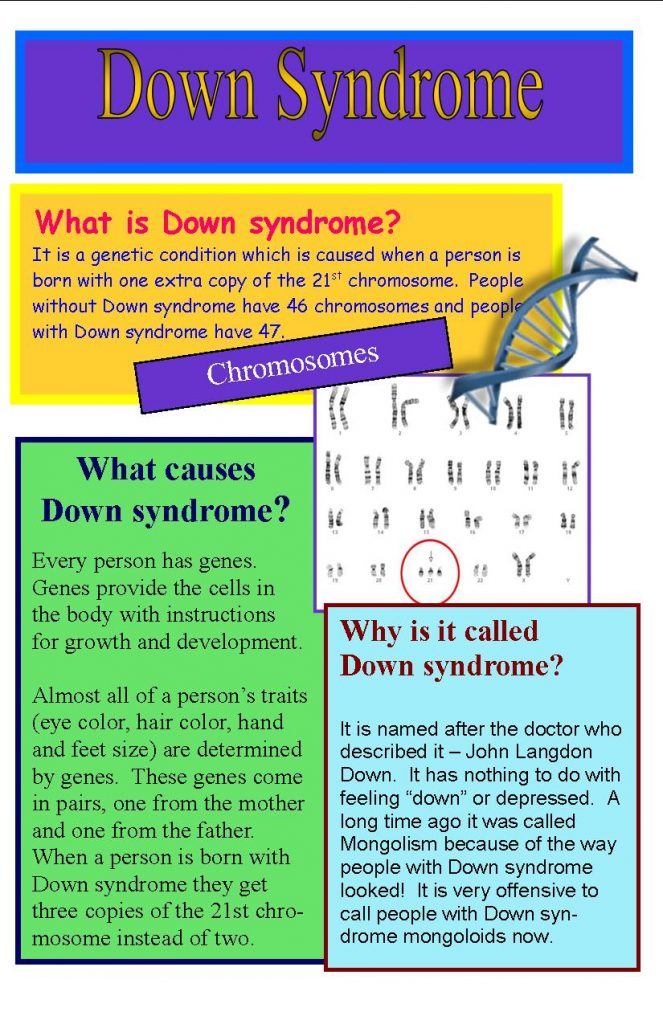Down disorder is a condition wherein an individual has an additional chromosome.

What
is Down syndrome?
Down disorder is a condition where an individual has an additional chromosome. Chromosomes are little “bundles” of qualities in the body. They decide how a child’s body structures during pregnancy and how the infant’s body capacities as it develops in the belly and after birth. Normally, an infant is brought into the world with 46 chromosomes. Infants with down disorder have an additional duplicate of one of these chromosomes, chromosome 21. A medicinal term for having an additional duplicate of a chromosome is ‘trisomy.’ Down disorder is likewise alluded to as Trisomy 21. This additional duplicate changes how the child’s body and mind create, which can cause both mental and physical difficulties for the infant.

Despite the fact that individuals with down disorder may
act and seem to be comparative, every individual has various capacities.
Individuals with down disorder normally have an IQ (a proportion of insight) in
the gently to-tolerably low range and are slower to talk than other kids.
Some normal physical highlights of down disorder include:
*A smoothed face, particularly the scaffold of the nose
*Almond-formed eyes that inclination up
*A short neck
*Little ears
*A tongue that will in general stick out of the mouth
*Small white spots on the iris (shaded piece) of the eye
*Little hands and feet
*A solitary line over the palm of the hand (palmar wrinkle)
*Little pinky fingers that occasionally bend toward the
thumb
*Poor muscle tone or free joints
*Shorter in tallness as youngsters and grown-ups
What
number of Babies are born with Down syndrome?
Down disorder remains the most widely recognized
chromosomal condition analyzed in the United States. Every year, around 6,000
infants conceived in the United States have down disorder. This implies Down
disorder happens in around 1 in each 700 babies.1
Sorts
of Down syndrome
*There are three sorts of Down disorder. Individuals
frequently can’t differentiate between each sort without taking a gander at the
chromosomes in light of the fact that the physical highlights and practices are
comparative.
*Trisomy 21: About 95% of individuals with down disorder
have Trisomy 21.2 With this kind of Down disorder, every cell in the body has 3
separate duplicates of chromosome 21 rather than the typical 2 duplicates.
*Translocation Down disorder: This sort represents a little level of
individuals with Down disorder (about 3%).2 This happens when an additional
part or an entire additional chromosome 21 is available, yet it is appended or
“trans-situated” to an alternate chromosome as opposed to being a
different chromosome 21.
*Mosaic Down disorder: This sort influences about 2% of the individuals
with Down syndrome.2 Mosaic methods blend or mix. For kids with mosaic Down
disorder, a portion of their cells have 3 duplicates of chromosome 21, yet
different cells have the ordinary two duplicates of chromosome 21. Youngsters
with mosaic down disorder may have indistinguishable highlights from other kids
with down disorder. Be that as it may, they may have less highlights of the
condition because of the nearness of a few (or many) cells with a run of the
mill number of chromosomes.
Causes
and Risk Factors
The additional chromosome 21 prompts the physical
highlights and formative difficulties that can happen among individuals with
down disorder. Analysts realize that down disorder is brought about by an
additional chromosome, however nobody knows without a doubt why down disorder
happens or what number of various components assume a job.
One factor that builds the hazard for having a child with
down disorder is the mother’s age. Ladies who are 35 years or more seasoned
when they become pregnant are bound to have a pregnancy influenced by Down
disorder than ladies who become pregnant at a more youthful age.3-5However,
most of infants with Down disorder are destined to moms under 35 years of age,
on the grounds that there are a lot more births among more youthful women.6, 7
Analysis
There are two fundamental kinds of tests accessible to
recognize down disorder during pregnancy: screening tests and analytic tests. A
screening test can tell a lady and her human services supplier whether her
pregnancy has a lower or higher possibility of having down disorder. Screening
tests don’t give a flat out finding, yet they are more secure for the mother
and the creating child. Analytic tests can normally distinguish whether an
infant will have down disorder, however they can be progressively dangerous for
the mother and creating infant. Neither screening nor demonstrative tests can
anticipate the full effect of down disorder on a child; nobody can foresee
this.
Screening
Tests
Screening tests regularly incorporate a mix of a blood
test, which gauges the measure of different substances in the mother’s blood
(e.g., MS-AFP, Triple Screen, Quad-screen), and a ultrasound, which makes an
image of the infant. During an ultrasound, something the professional takes a
gander at is the liquid behind the infant’s neck. Additional liquid right now
show a hereditary issue. These screening tests can help decide the child’s
danger of down disorder. Once in a while, screening tests can give a strange
outcome in any event, when there is nothing amiss with the infant. Once in a
while, the test outcomes are ordinary but they miss an issue that exists.
Demonstrative
Tests
*Demonstrative tests are typically performed after a
positive screening test so as to affirm a Down disorder analysis. Kinds of
symptomatic tests include:
*Chorionic villus inspecting (CVS) — looks at material from
the placenta
*Amniocentesis—analyzes the amniotic liquid (the liquid
from the sac encompassing the child)
*Percutaneous umbilical blood inspecting (PUBS) — looks at
blood from the umbilical rope
These tests search for changes in the chromosomes that
would demonstrate a Down disorder determination.
Other
Health Problems
Numerous individuals with down disorder have the basic
facial highlights and no other significant birth surrenders. In any case, a few
people with down disorder may have at least one significant birth surrenders or
other medicinal issues. A portion of the more typical medical issues among kids
with down disorder are recorded below.8
Hearing
Obstructive
rest apnea, which is where the individual’s breathing briefly stops while
sleeping
*Ear diseases
*Eye illnesses
*Heart abandons present during childbirth
Medicinal services suppliers routinely screen youngsters
with down disorder for these conditions.
Medications
Down disorder is a deep rooted condition.
Administrations right off the bat in life will frequently help infants and kids
with down disorder to improve their physical and scholarly capacities. A large
portion of these administrations center around helping kids with down disorder
create to their maximum capacity. These administrations incorporate discourse,
word related, and exercise based recuperation, and they are ordinarily offered
through early mediation programs in each state. Youngsters with down disorder
may likewise require additional assistance or consideration in school, albeit
numerous kids are remembered for ordinary classes.